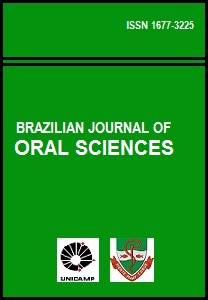Abstract
Aim: To evaluate the surface roughness of the resin Filtek Z350 (3M ESPE) after different finishing and polishing techniques. Methods: Sixty specimens of 7x2 mm were made and distributed in 6 groups (n=10), according to the technique employed: G1 (control) – polyester strip – no finishing or polishing; G2- multi-blade burs; G3- diamond burs 3195F and 3195FF; G4- Diamond Pro Discs (FGM); G5- Sof-Lex Discs (3M ESPE); G6- Robinson bristle brushes with pumice paste for 20 s and felt disc with 2-4 µm diamond paste for 30 s. The specimens were stored in artificial saliva at 37°C for 7 days. After the finishing and polishing techniques, surface roughness (Ra, µm) was measured using Surf-Corder profilometer SE 1700. Data were subjected to one-way ANOVA and Tukey’s test at 5% significance level. Results: G3 presented the highest surface roughness mean value (0.61). G5 presented the lowest surface roughness mean value (0.15), but it was not significantly different from G1, G4 and G6. Conclusions: According to the obtained results, Z350 composite resin presented the lowest surface roughness when finishing and polishing systems were used (Sof-lex and Diamond Pro discs and Robinson bristle brush with pumice plus Diamond® felt disc with Diamond Excel® paste). The use of diamond burs (G3) resulted in the highest composite surface roughness. There was no significantly different between G1, G4, G5 and G6.The Brazilian Journal of Oral Sciences uses the Creative Commons license (CC), thus preserving the integrity of the articles in an open access environment.
Downloads
Download data is not yet available.

